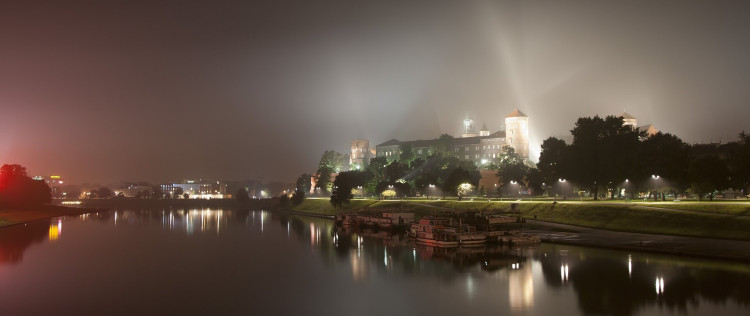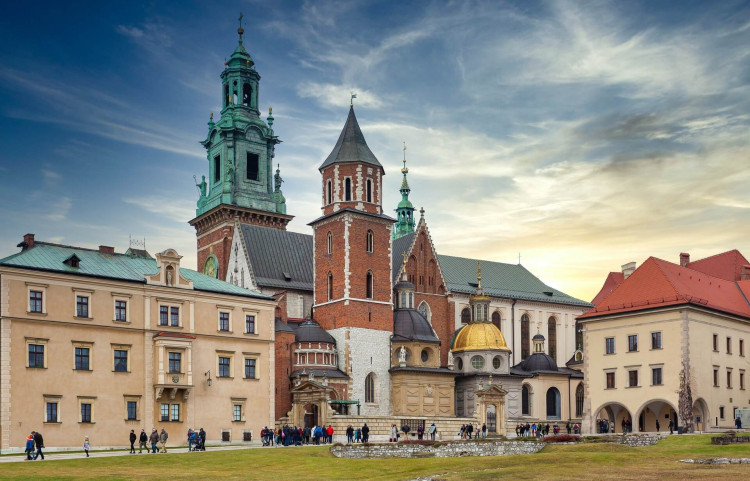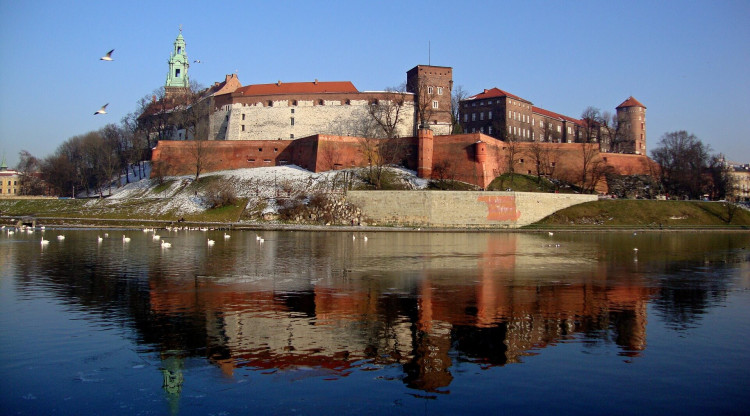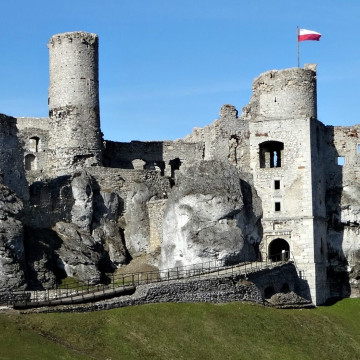Wawel Castle - the seat of Polish kings in Cracow
Where is located Wawel Castle?
Address of Wawel Castle is Wawel 5 31-001 Cracow, Poland
show on map
When was built Wawel Castle?
Built date of Wawel Castle is From the 10th century to the 13th / 14th century

Facts, informations and history of Wawel Castle
Wawel Castle is a former seat of Polish kings, a monarch and a national necropolis located in the heart of Krakow.
This Jurassic limestone rock rises on the left bank of the Vistula. The first settlers on Wawel Hill come from the Paleolithic period.
In the 11th century Polish monarchs built the Royal Castle in Gothic style on a hill. In the following centuries the castle was reformed, its construction was transformed into a structure in the Renaissance style.
In the times of the first Polish kings from the Piast dynasty, Wawel Castle was one of the first royal seats. Mieszko I (ca. 962-992) chose Wawel Castle as one of the official residences.
Wladyslaw Lokietek was crowned and then moved to Wawel Castle in the 14th century, so the new royal seat was established. The golden age of Wawel Castle fell during the reign of the Jagiellons, then it was during the reign of the kings Sigismund III the Old and Sigismund Augustus, fascinated by the Renaissance movement in Europe, that their main seat was given a truly modern character.
In 1596 the Polish capital was moved from Cracow to Warsaw. After that time the Royal Castle was abandoned and plundered by the Prussian army. The building was then occupied by the Austrians, who built the city walls around the castle and transformed its interior in order to strengthen it.
During World War II, Governor General Hans Frank resided in the palace.
Wawel Castle is a complex of buildings surrounding a majestic courtyard. The cathedral (Wawel Cathedral) located here has its own towers. In the 16th century the famous arcade courtyard of Wawel Castle was built, and the Renaissance castle replaced the former Gothic castle.
The Wawel Castle's outstanding buildings are the Hall with 24 pillars, the building at the Dragon's Den (Romanesque tower), St. Gereon's Church, St. Michael's Church (Romanesque) and the rotunda with the empora at the Sandomierz Tower.
With the west, the church has two towers: the Clock Tower (the higher one) and the Silver Bells (the lower one, called the Vicar's). At the northern elevation of the cathedral stands the Sigismund Tower, with 5 bells, the largest of which weighs 11 tons. The remaining towers on the north and east side are: John III Sobieski, Zygmunt III Vasa, Kurza Stopka, Danish and Jordanka.
The first cathedral in this place was built of wood, probably around 1020. It was consumed by fire and then replaced by the second cathedral, which then also burned down. The present building was consecrated in 1364 and built by order of the first king of Poland crowned at Wawel Castle - Wladyslaw Lokietek.
Wawel Cathedral has been the most important place of worship in Poland for centuries. It was also the most important, richest and prestigious diocese. In 1320 the coronation of the Polish king Wladyslaw Lokietek, and since then also his successors, took place here. It was the burial place of Polish kings and queens, and since the 19th century also of national heroes.
The chapel has the status of a monument of national history. The crypt of the cathedral is used as the last resting place of practically every king and national hero in Poland, including Tadeusz Kościuszko and Józef Piłsudski.
In the second half of the 20th century Wawel Castle was renovated and started to open most of its chambers and buildings to the public. Tourists are attracted by the rich interiors, artistic and military collections, as well as impressive fortifications which are a true showcase of Krakow.
The restored castle on its two floors houses 71 exhibition rooms. There is a monarch residence with three wings and one screen, an inner courtyard with arcaded cloisters, an entrance gate and four residential towers.
The museum located here today was founded in 1930 and is one of the most important museums in the country. It consists of ten sections covering the collection of paintings, including an important collection of Italian Renaissance painting, as well as the Lanckoroński collection. Here you can admire works of art historically or artistically connected with the Wawel Castle, with the Polish rulers, as well as large collections of magnates, numerous graphics, sculptures, textiles, including the collection of Sigismund II August tapestries, goldsmiths' works, weapons and armour, ceramics, Meissen porcelain and furniture. The collection of the Museum of Oriental Art includes the largest collection of Ottoman tents in Europe.
With seven specialized conservation workshops, the museum is also an important center for the conservation of works of art.
The castle is divided into several permanent, seasonal and temporary exhibitions. There are six permanent exhibitions: Representative Royal Chambers and Private Royal Apartments, Crown Treasury and Armory, Eastern Art, Lost Wawel Castle and Recovered Wawel Castle.
The Royal Castle hosts numerous events, including symphonic and chamber music concerts as well as opera and court dance shows.
Wawel Castle is currently one of the most popular tourist attractions in Cracow, with about 2.1 million tourists visiting it every year.
With the Wawel Castle there is a legend which says that the first settlers in Cracow were haunted by the terrible Wawel Dragon. The dragon terrorized people, devoured their supplies and virgins. It lived in a cave under the hill near the banks of the Vistula. However, thanks to the courage of Prince Krak, he was deceived and killed, and the people were free. Krak was named in his honour.
The Dragon's Cave is now open to the public, 82 m long, and at its exit there is a statue of the mythical Dragon, which is burning every 5 minutes.
"Here before Tatar
Cracow defended itself.
From here Jagiello walked
to threaten the Teutonic Knights.
Here the bell rings
bronchial heart.
Here are souvenirs
our most sincere." - Czesław Janczarski, Wawel
Architect of Wawel Castle
Construction/building type
Building Wawel Castle is of type Castle
Architectural style
Architectural style of Wawel Castle is Renaissance, Gothic, Baroque, Romanesque
The Renaissance is an architectural style that developed in Europe in the 15th and 16th centuries, characterised by a return to the classical forms and elements of ancient Greek and Roman architecture. The Renaissance was a reaction to the Gothic style that prevailed in Europe from the 12th to 15th centuries and was associated with churches and sacred buildings. Renaissance means 'rebirth' and the style is considered the precursor to modern architecture. ... czytaj więcej.
Other dimensions, parameters and frequently asked questions

What area have Wawel Castle?
Wawel Castle have area of 7,040 m² - castle area
What material is the building made of?
Wawel Castle is made of the following materials: Stone, wood
Practical informations

What is the cost of entry for Wawel Castle?
Tickets for Wawel Castle are available at the following prices and variants:
- Admission to the hill and the arcade courtyard is free.
- Tickets to the Representative Royal Chambers, Crown Treasury and Armoury, Turkish Tents, St. Gereon's Church are paid individually, at a price of about 15 zł reduced, 20-25 zł normal.
At what times is open Wawel Castle?
Wawel Castle is open or accessible to the public on the following dates and times:
- The Wawel Hill is open:
- April and September: 06:00 - 19:00.
- May-August: 06:00 - 20:00.
- November-February: 06:00 - 17:00.
- March and October: 06:00 - 18:00.
Is the building on the UNESCO World Heritage List?

The listing took place in the year 1978.
Details of the entry are available on the Unesco website at https://whc.unesco.org/en/list/29bis/
Official website
The official website of the building, where up-to-date information can be found, is http://www.wawel.krakow.pl/
Photo gallery Add photo
Location on map / How to get there






























Comments to Wawel Castle (1) Average rating: 4 Add comment / Rate building
Based on 1 comment